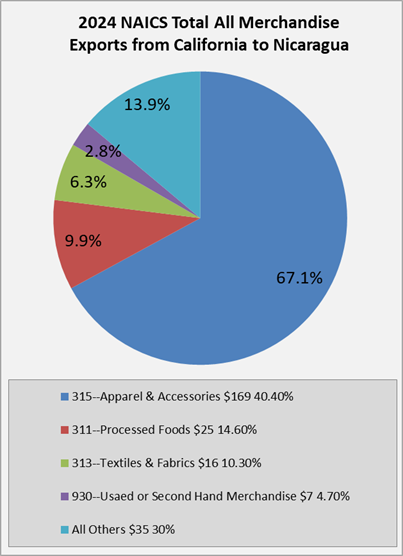Trading Partner Portal: Nicaragua
Overview
Trade Overview

Nicaragua is a country with a geographical size slightly smaller than the state of New York in Central America and the Caribbean. The World Bank classifies Nicaragua as a lower middle-income country with a GDP of $17 billion. The population was recorded as approximately 41.1 million people in 2023. Nicaragua is the poorest country in Central America and the second poorest in the Western Hemisphere. World Bank, CIA
Nicaragua’s economy has improved since 2006, due to the increase in exporting capabilities with the implementation of the Dominican Republic Central America Free Trade Agreement with the United States. The United States not only has an established trade relationship with Nicaragua, but there are also flows of investment across their borders.
U.S. – Nicaragua Trade
The United States is currently Nicaragua’s largest trading partner, as their largest export destination and their largest importer of goods. Nicaragua has a history of exporting agricultural goods, such as coffee, beef and sugar. They also have exported valuable metals like gold and silver. However, Nicaragua also has a large export market of manufactured textiles. US Department of Commerce, BEA
The United States exported $2.75 billion worth of goods to Nicaragua in 2024. The key exports to Nicaragua included petroleum and coal products ($695 million), oil and gas ($310 million), processed foods ($277 million), computer and electronic products ($239 million), agricultural products ($234 million). U.S. Department of Commerce
In 2024, the United States imported $4.62 billion worth of goods from Nicaragua, with $1.96 billion of those goods being apparel and accessories. Other imports from Nicaragua included transportation equipment ($702 million), primary metal manufactures ($583 million), processed foods ($510 million), and agricultural products ($411 million).
Nicaragua – California Trade

In the United States, California is one of the top exporters to Nicaragua, exporting $252 million worth of goods to Nicaragua in 2024. Top exports included apparel and accessory ($169 million), processed foods ($25 million), textiles and fabrics ($16 million), used or secondhand merchandise ($7 million), and computer & electronic products ($6 million).
In 2024, California imported $327 million worth of goods from Nicaragua. $152 million was in processed foods. Other key imported products from Nicaragua to California were apparel & accessories ($99 million), agricultural products ($63 million), fish and other marine products ($9 million) m and goods returned ($2 million). U.S. Department of Commerce
FDI – Nicaragua
U.S. foreign direct investment into Nicaragua totaled $340 million in 2023 a 11.1 percent increase from 2022.
Preliminary Overview of the Economies of Latin America and the Caribbean
ECLAC, December 2019
Trade Agreements
Trade Agreements
Yes, Really: It’s Time to Revive Hemispheric Trade Talks
Latin Trade, August 6, 2020
CAFTA-DR (Dominican Republic- Central America Free Trade Agreement)
The United States trade deal with some of the small developing countries in Central America was signed by President George W. Bush in 2005 as an expansion of North American Free Trade Agreement for the US. Members of this free trade agreement include the United States, Costa Rica, El Salvador, Guatemala, Honduras, Nicaragua, and the Dominican Republic. This trade agreement has led for this group to become the US’s 16th largest trading partner in commodities. Exports from the United States to this group of countries totaled $29 billion in 2015, while imports totaled approximately $24 billion. This trade agreement ensures that 100% of goods from the United States are not subject to tariffs in these countries, it also has a goal of phasing out all tariffs on agricultural products by 2020.
Events
Events
Central American Ambassadors Promote Benefits of Trade Agreement with U.S.
(March 8, 2005) The California Chamber of Commerce hosted five ambassadors representing the nations included in the proposed U.S.- Central American Free Trade Agreement (CAFTA) at an International Luncheon Forum on March 8, 2005.
Central American Ambassadors Promote Benefi ts of Trade Agreement with U.S.